Is your laptop absolutely crawling? Can you drive to Starbucks, buy coffee beans, come home and grind them, boil water, dump everything in your French press, wait 4 minutes for it to steep, pour your freshly-brewed cup of coffee into a mug and still get back to your desk in the time it takes your machine to reboot?
That’s where I was earlier this week. And tired of it!
So let’s just say I’m not running a high-end laptop here. Mine is squarely in the middle of the road.
It was perfectly usable 2 years ago when I bought it, but I made it out of my local Best Buy with $20 left of my $500 budget at the time. (I decided a long time ago that laptops are almost disposable, so I refuse to pay big bucks for them.)
But 2 years of updates to Windows 7 (which I love, by the way… another reason why I don’t want to buy a new one yet), 2 years of installing various bits of software, a really bad habit of having 50-60 Chrome tabs open at once, and a tendency to run Photoshop or InDesign (or both) all adds up to a really terrible user experience.
I’d already maxed out the RAM… I did that about 6 months after I bought it.
So… what was left to do?
Well… SSD envy set in about a year ago when I bought my wife an HP Ultrabook. She gets a higher laptop budget because she replaces them less often, and she doesn’t subject them to all the abuse of travel nearly as often as I do. Oh… and she likes them light and thin. And boy is hers ever light and thin! But it’s also blazingly fast. I’m talking… Windows 7 reboots completely in under 10 seconds. Forget that cup of coffee and keep working!
One of the reasons the thing is so darn fast is because of the Solid State Drive (SSD) that was installed from the factory. SSDs, if you aren’t already aware, are much faster than traditional hard drives because they have no moving parts. That’s right, no motors or spindles… just pure NAND flash memory (usually), and lots and lots of speed.
So… I began scheming back then about when (and how) I could get an SSD into my laptop. But the problem is that I do have much more significant storage needs. My laptop has a 500GB drive, and I keep it nearly full with stuff. Could I be more diligent and picky about what stays on my hard drive? Sure. But that takes time. Plus, I’m always of the opinion that I’d rather have that obscure file with me when I’m traveling because of the one time I get somewhere and need something that other people would’ve left on an external drive back home.
Why is that a problem for SSDs? Well… they don’t tend to do so well with higher capacities. And they’re expensive — quite unreasonably so when it comes to the higher capacities. In fact, had I been looking at a 500GB (or bigger) SSD, I’d have been back in the “that costs more than a new machine” zone.
So a few months ago I ran across this nifty idea. Some manufacturers had begun to produce “SSD Caddies” that take the place of an optical (DVD or CD-ROM) drive in a laptop. The idea is that you yank the DVD drive that came with your laptop and drop an SSD into one of these caddies and stick it in your machine instead.
Hmmmmm…. but IÂ use that DVD drive, don’t I?
I decided to find out. When I’d gone more than 30 days without even opening it, I realized that the idea that I needed one was actually legitimately outdated.
So I waited for the right moment… in my case, it was an afternoon of waiting, waiting, waiting for some file to open while something else was running and my physical memory usage was up over 90% and 10 minutes of staring at the dumb blue blinking LED Â that represents hard drive activity had passed without the light ever flickering (because it was on solid from activity)… annnnnnnnd, I’d had enough.
I took the plunge, ordered the parts, and began the long, drawn-out process of waiting 2 business days for shipping. (Sad, I know.)
What Do You Need?
Well first, you’ll need an SSD caddy that matches your machine. At first, I searched for one that was clearly advertised as made for my particular laptop (using the manufacturer name and model number of my laptop). That seemed like a good idea. Price? Around $45 from some unknown online vendor.
Hmmmm…. I wonder…. is this laptop really all that unique?
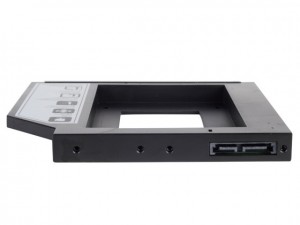
So, I did some more digging around and found SilverStone Technology. They seem to make a handful of these unusual gadgets, and in my research, the TS09 model seemed like a good fit for my laptop (even though no specific laptops were mentioned).
To make sure it would work, I located the proper method for removing my ODD (optical disk drive), just to do some quick measurements.
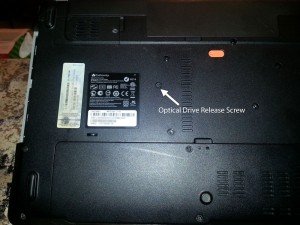
For my Gateway NV57H44u, the optical drive (DVD writer, in this case) is held in place by a single screw which is located to the right of the Windows 7 COA label and Gateway info sticker.
I few twists with a screwdriver (while the machine was turned off, power supply disconnected and battery removed, of course), and the optical drive came free. I tugged on it to get it out, and checked it with a ruler. It was, in fact, a 12.7mm height drive. This is something of a “standard” size, although you’ll want to confirm with your manufacturer regarding the specs for your device (or just measure like I did).
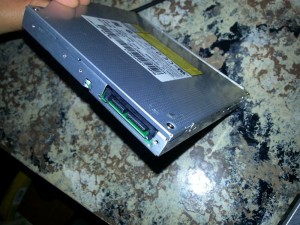
The next thing I wanted to verify was that the optical drive that shipped with my laptop was using a typical “slimline” SATA connector (shown in photo). This is how the device gets power and how it communicates with your system. It was, so the TS09 looked like it might be the right fit. At less than half the price ($20 from Amazon) of the other caddy I’d looked at, this was feeling more and more like the right way to go.
The next big question:Â which SSD to get?
Well, this is where I’d done my homework. After lots of research, I had decided on the Samsung 840 series. The problem you may run into is that there are at least 3 different types of drives bearing that moniker: the 840, the 840 EVO, and the 840 PRO.
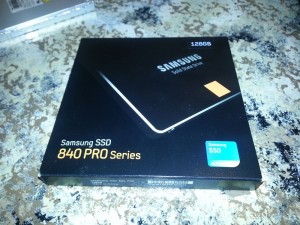
These drives are significantly different. Sure, they all look nearly identical, and they all have “840” in the name. Frankly, they’re all fairly reputable as well.
You’ll find conflicting opinions—such as in this Tom’s hardware thread comparing Samsung 840 series models—but at the end of the day, the PRO won me over because of its speed and long-term reliability, despite its higher pricetag.
The next decision I had to make was about capacity… which, frankly, is all about how much you want to spend. I’d already decided that since my SSD was a new, second hard drive (and I was keeping my original 500GB drive for storage), I could live with having only 128GB on it. This is plenty for me to install Windows 7 and a few core applications that I need to run speedily (Google Chrome, the Adobe Creative Suite apps like Photoshop, InDesign, Illustrator, etc.) and Microsoft Office. All my data would stay on the traditional hard drive that shipped with my laptop.
So… the 840 Pro ran me about $130 on Amazon. Prices fluctuate. At this writing, it’s already down to $114.
Now… you can find 128GB SSDs for less. I’m guessing that even the 840 EVO (120GB) or standard 840 would be decent choices. I was willing to spend a little more for the PRO because I just don’t like to gamble with hard drives. Any of them can (and do) fail, so there are certainly no guarantees, but I prefer to give myself the best chances right out of the gate. Also, the PRO model’s additional speed was important to me, since speed was the whole reason to take this project on to begin with.
So you need an SSD and a caddy. That’s it!
Well… at least that’s it for hardware.
Unboxing the 840 PRO was a breeze. It dropped into the TS09 caddy, no problem. The trickiest part was deciding which of the screws to use to cinch it down to the caddy, which shipped with a couple of different sets for you to use. You can’t goof this part up, though, since the screws either fit or they don’t.
Once the drive was secured to the caddy, it only remained to insert the caddy into the laptop. One detail that could easily be missed is that the retaining screw (remember the screw that I removed earlier to loosen the optical drive?) has to screw into something. On my optical drive, there was a small metal bracket which received the screw and held it in place. I removed that bracket from the optical drive (it’s obviously a separate piece) and attached it to the same spot on the caddy, which had a hole in just the right place for it.
Once inserted, I fired up the laptop to make sure that everything was working. I saw a very satisfying green and blue color emanating from the new SSD’s LEDs, which shone through the well-placed hole in the caddy.
OK, Everything’s Installed… Now What?
Well… this is where you have some options about how to proceed.
To get the maximum benefit out of your SSD, you’re going to want it to be your primary drive… meaning the one that Windows (or your O/S of choice) is installed on.
There are two major ways to make this happen: migration or clean install.
If you choose to migrate, you’ll essentially be moving your current Windows installation from your existing hard drive over to your SSD. There are a few advantages to this:
- It’s easier (in theory, at least)… the 840 PRO series ships with migration software designed to make this happen for you. (Ironically, it ships on a CD. So, if you’re adding the SSD to your system instead of replacing your primary hard drive with it, you’ll need to plug your optical drive back in to use it.)
- You keep your current Windows setup completely intact. This means you don’t need to re-install any software, locate drivers, find product keys, installation files, etc. You’ll also keep your all-too familiar configuration… simple things like desktop backgrounds, sound “themes” and even locations of files will (most likely) all stay exactly the same as before.
- You may find that you’re up and running faster. Once you complete the migration, you reboot, and you’re in business. No need to install every Windows update since the beginning of time… and so on.
On the down side, migration:
- keeps all the crud that’s built up over time in your Windows installation. Software that you install and subsequently uninstall leaves traces behind… clogging up your Windows registry and ultimately slowing things down. Admittedly, I’m a power user, so I’m more prone to this sort of thing, but it’s worth a consideration. If you have only installed a few pieces of software, this is a non-issue. But if you’re like me and you’ve forgotten about more software than you remember, then those small effects can really add up.
- may not work! If you’re moving from a 500GB hard drive (that’s nearly full) to a 128GB hard drive, you can do the math. The important things that need to be moved are the boot partition and your O/S itself. However, if you had only one partition on your hard drive—which is how virtually every laptop ships from the manufacturer—and not separate partitions for your O/S and your data, then you’re going to have problems. The migration process may not adequately handle all the details that need to be handled, leaving you with a mess. On the other hand, if you are moving to an SSD with equivalent (or greater) capacity (or if you have a boot partition that’s equivalent or smaller than your new SSD), then you won’t have this consideration to worry about.
Besides migration, your other option is to perform a clean install of Windows. This means that you’ll be starting fresh… possibly even enjoying that OOBE (“out of box experience”) like you did on day 1 with your PC all over again.
Some of the advantages to a clean install are:
- You’ll have a clean slate. Only software that you choose to install will be installed. Often, this single factor alone can produce enough of a speed boost that people will do it even without moving to a faster hard drive.
- You can map out your new configuration as you see fit. Where will your “My Documents” folder be located? (i.e. Which drive will it live on?) Which programs do you want installed on the SSD (because you particularly need them to run faster) and which ones can stay on your legacy hard drive?
- Keeping your SSD clutter-free. I personally don’t want to store data and other static files unnecessarily on the SSD. It’s intended to be lean, fast, and unencumbered. My older hard drive can shoulder the load for storage and so forth.
Disadvantages to a clean install include:
- It can be a pain to do. Ever tried installing Windows 7 to a laptop without a Windows 7 installation CD/DVD? Even more fun… without a place to put the CD/DVD (since you yanked your DVD drive out to make room for your SSD)! A little extra effort (and perhaps some downright creativity) is required to pull this off.
- You may be out of commission longer. Nothing will be installed on your laptop until you install it. This means you’ll start with the essentials (Windows, Chrome, and your most-used software), and then you may find yourself discovering another missing item weeks afterward.
- Once you’re up and running, additional energy may be required to get everything back to where you like it.
For me, the decision between a migration and a clean install was a complete no-brainer: hands-down, I wanted a clean install. I was looking to squeeze every possible ounce of benefit (read: speed) out of this project. There’s no better way to pull that off than to start fresh with Windows. Being the extremist that I am (at times), I wanted to even be sure I avoided any of the bloatware that Gateway originally installed on my machine. So… I chose to not even bother trying to use the “recovery” partition. Instead, I went on the hunt for an official Microsoft image of Windows 7 to install.
Being a geek, I’ve performed many a clean install of Windows. Even so, it had been a while… so, I made a couple of blunders that cost me a little bit of time. Here are some notes so you can perhaps avoid running into any problems yourself.
- Prepare your Windows installer ahead of time. Before you take the big plunge and render your existing setup inoperable, do yourself a favor and get everything ready. It’s a long story, but I ended up needing to use another computer to do this. Chances are, you don’t have a Windows CD or DVD to install from, since most manufacturers quit distributing them long ago. So, you’ll have to work around this dilemma, which means you’re going to need a 4GB or larger USB flash drive, and you’ll also need to…
- Understand which version of Windows you have. If you bought your PC at retail, then you have the “OEM” version of Windows. That product key on the colorful COA sticker on the bottom of your laptop won’t work if you try to install the “retail” version of Windows. You also need to know if you’re using the 32-bit or 64-bit version. Once you figure out which one you have (mine worked out to be “Windows 7 64-bit Home Premium OEM”), you’ll need to download an .ISO file (DVD image) for that version. There are lots of places to look for these… some of them legitimate (read: legal) and some of them less so. To save time and energy, I located a version that included SP1 (“Service Pack 1”), which had a huge batch of the earliest Windows 7 updates rolled up into it already.
- Create a bootable USB drive with your Windows installer on it. Once you’ve located and downloaded an appropriate .ISO file, you can use Microsoft’s official Windows 7 USB/DVD download tool (more info about this here) to push the Windows 7 installer to your USB flash drive. (Note: I had a little trouble with this tool… in fact, it never did completely finish without an error. But I finally realized that if the tool made it to 98% before the error occurred, then chances are it actually had finished. This turned out to be true.)
- Before you get started installing, download all the drivers for your machine. Hit your laptop manufacturer’s website and locate the downloads for your model number. You’re going to need (at least): the chipset driver, video driver, audio driver, and network drivers for both LAN and wireless. You may also need to get drivers for your touchpad, webcam, card reader, bluetooth device and maybe some other peripherals in your system. That last batch can be downloaded from your new, fresh Windows install if necessary. But you’ll want the first batch in a folder on your USB stick so they’ll be handy when Windows comes up for the first time.
- Block off some time and be ready to reboot quite a few times. The actual Windows 7 installation went pretty quickly for me… maybe even under an hour. Once you have your basic driver set installed, however, Windows 7 will start pulling down updates. They number into the hundreds… and that’s when you start from SP1! Some of your drivers will even require a reboot upon installation, which is a good idea.
- Get your other software installation media ready to go as well. If you need to install other programs (such as Microsoft Office apps) from a CD, it’s a good idea to get those installers onto your USB stick ahead of time also. Many, many programs can be downloaded, so if you aren’t able to locate discs, it may not be the end of the world.
Once you’ve got your tools in place, then plug that USB stick in and go!
My laptop had no problem booting from the USB flash drive, and when the Windows 7 installer came up, it was pretty clear which drive I wanted to target for the installation. Be careful to select the right drive, though, as choosing the wrong option from the installer could end up wiping your existing hard drive. I plan to keep all the data on that drive (eventually I’ll delete the Windows folder, I guess), especially at first, so I made sure that Windows 7 got installed to my brand new SSD.
Once the Windows 7 installer reaches the point where it needs to reboot, you may want to take a look at your BIOS or “Boot Order” settings. My machine’s BIOS didn’t recognize the SSD as a hard drive in the boot sequence options, which led to a moment of panic. It did, however, still show the option of booting from the CD-ROM/DVD-ROM drive, which I realized pointed to the SATA channel that the SSD was connected to. So, I set the machine up to boot from that first (once I was finished with the USB flash drive portion of the process), and it worked like a charm.
As the installation process completes and a reboot is necessary, you may see an option to select from a couple of different Windows 7 installations at boot-up. The “top” option will be your new one. In my case, I can still boot to the previous Windows 7 install (from my legacy hard drive) using the 2nd option. This is nice for when you need to locate that one setting (piece of software, etc.) you forgot about. Later, you can remove the 2nd entry if you want to eliminate this step in the boot process.
The Results
I’ve now had a couple of days to enjoy using my machine since installing the SSD and getting a clean install of Windows 7 going. Wow, what a difference! I’m certainly seeing all the speed benefits I was hoping for. All the waiting from hard drive lag is gone. Reads and writes to the drive are  pretty much invisible to me now. The machine boots up in a fraction of the time that it used to take. Some of the more hard-drive heavy software tools I use regularly (Photoshop, etc.) are faster than I’ve ever seen them on my own hardware.
An unexpected benefit that I’m seeing is a reduction in both heat and noise. The machine is quieter than ever… partly because the 2nd hard drive (meaning my legacy hard drive, which is now exclusively for storage) doesn’t have the constant read/write activity that made it noisy and caused it to get hot. In turn, with less heat in the chassis, the fan is running a lot less often. Those two combine to make this the quietest laptop I’ve ever owned.
Regarding battery life, I had expected it might suffer with the two hard drives. However, the power consumption of my SSD is virtually nil when compared to the legacy hard drive. Since the SSD is my boot drive (and my Windows drive), the reads and writes to the legacy drive are cut by 90% or more. Thus, I’m expecting to see a nice bump in battery life. I haven’t done any actual measurement of this yet, so I lack the evidence to make this claim unequivocally, but it wouldn’t surprise me if this bears out after some real testing.
In short, this is the best ~$150 I’ve ever spent upgrading a laptop. There is truly no comparison between the “after” and the “before.” I highly recommend it.
Even factoring in all the time I’ve spent… whether checking prices and doing my pre-planning or actually installing the gear and/or Windows and the accompanying joys of getting everything back up and running, this is well worth the effort. My payoff in terms of speed, responsiveness, and overall usability are beyond my wildest expectations.
In short: if you’re suffering from a slow laptop, add an SSD via a caddy and get yourself a major speed boost!

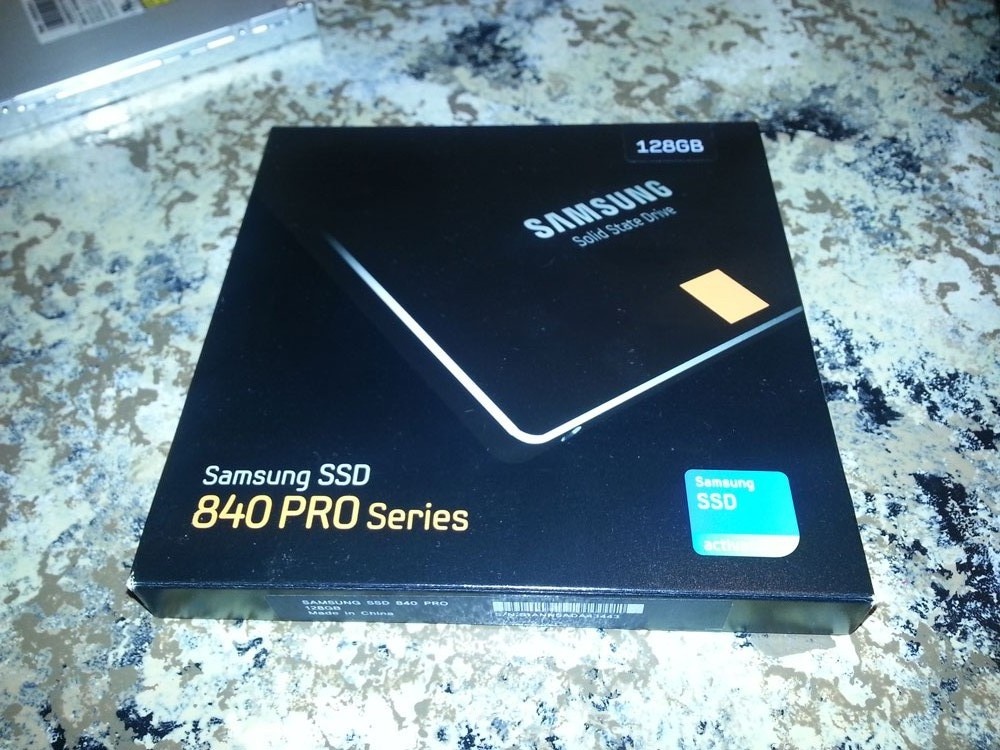
Your point of view caught my eye and was very interesting. Thanks. I have a question for you.